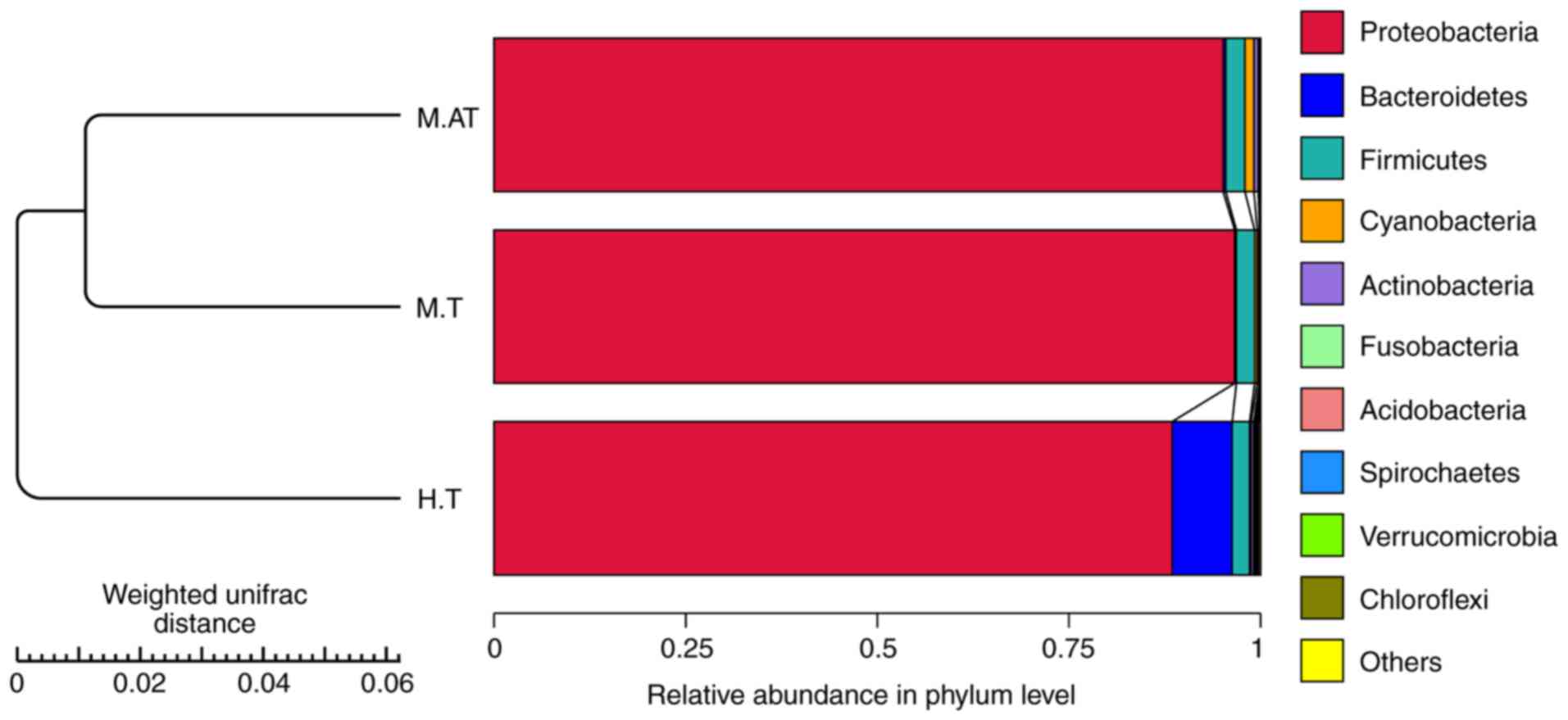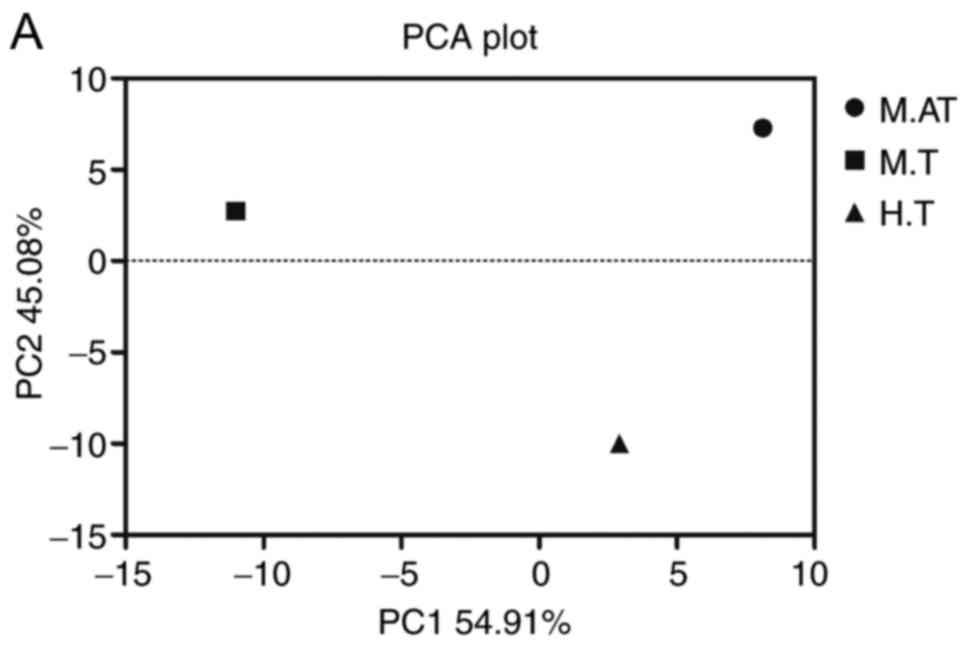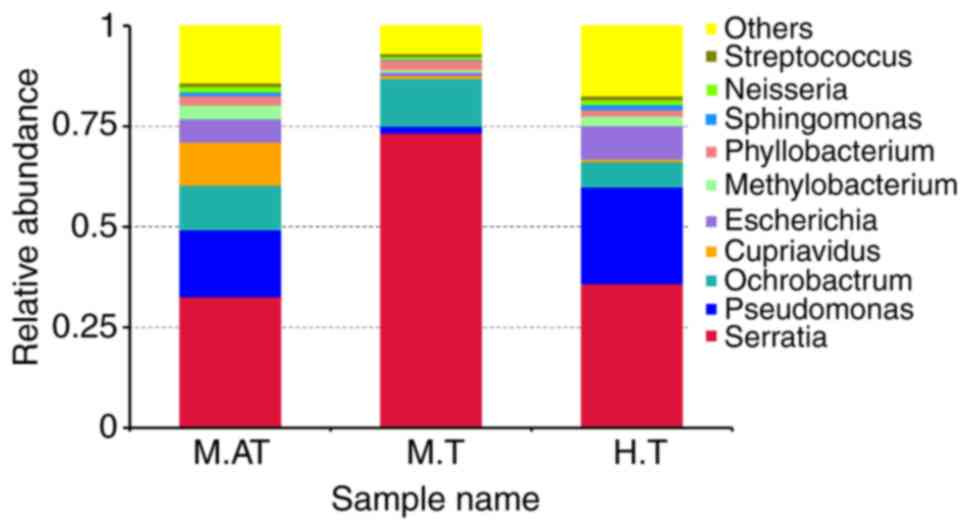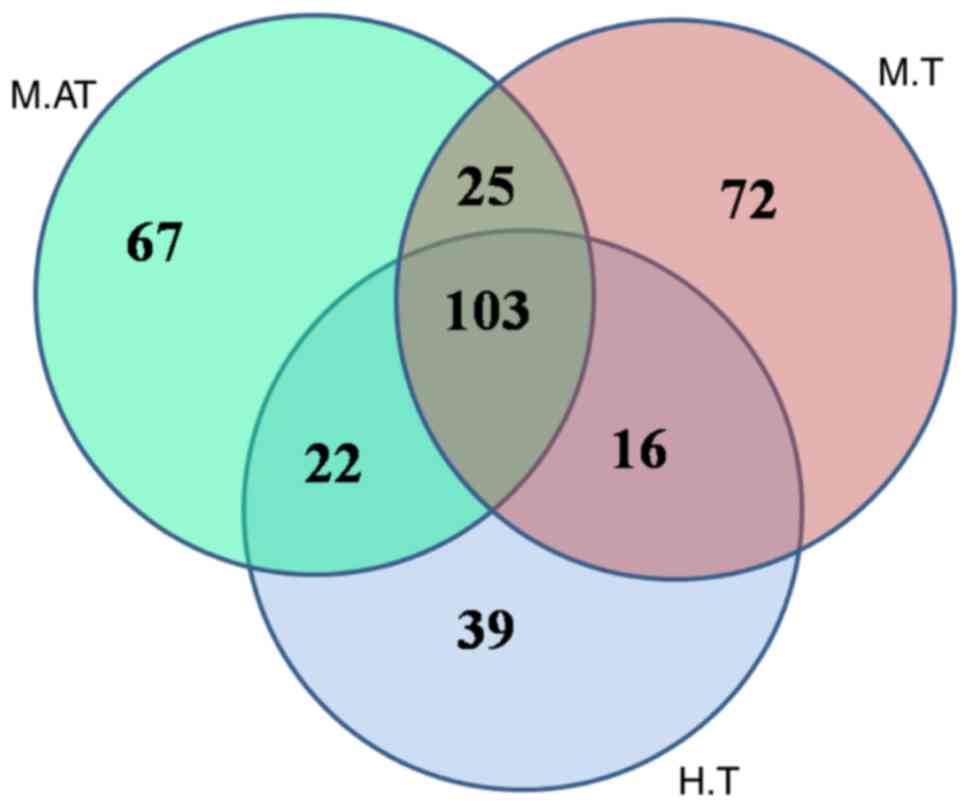|
1
|
Williams NS, Bailey H, Bulstrode CJ, Love
RM and O'Connell PR: Bailey & Love's Short Practice of Surgery.
CRC Press; Boca Raton, FL: 2008, View
Article : Google Scholar
|
|
2
|
Postow MA, Chesney J, Pavlick AC, Robert
C, Grossmann K, McDermott D, Linette GP, Meyer N, Giguere JK,
Agarwala SS, et al: Nivolumab and ipilimumab versus ipilimumab in
untreated melanoma. N Engl J Med. 372:2006–2017. 2015. View Article : Google Scholar : PubMed/NCBI
|
|
3
|
Sivan A, Corrales L, Hubert N, Williams
JB, Aquino-Michaels K, Earley ZM, Benyamin FW, Lei YM, Jabri B,
Alegre ML, et al: Commensal Bifidobacterium promotes
antitumor immunity and facilitates anti-PD-L1 efficacy. Science.
350:1084–1089. 2015. View Article : Google Scholar : PubMed/NCBI
|
|
4
|
Hoos A: Development of immuno-oncology
drugs-from CTLA4 to PD1 to the next generations. Nat Rev Drug
Discov. 15:235–247. 2016. View Article : Google Scholar : PubMed/NCBI
|
|
5
|
Vétizou M, Pitt JM, Daillère R, Lepage P,
Waldschmitt N, Flament C, Rusakiewicz S, Routy B, Roberti MP, Duong
CP, et al: Anticancer immunotherapy by CTLA-4 blockade relies on
the gut microbiota. Science. 350:1079–1084. 2015. View Article : Google Scholar : PubMed/NCBI
|
|
6
|
Maynard CL, Elson CO, Hatton RD and Weaver
CT: Reciprocal interactions of the intestinal microbiota and immune
system. Nature. 489:231–241. 2012. View Article : Google Scholar : PubMed/NCBI
|
|
7
|
Wei MQ, Mengesha A, Good D and Anné J:
Bacterial targeted tumour therapy-dawn of a new era. Cancer Lett.
259:16–27. 2008. View Article : Google Scholar : PubMed/NCBI
|
|
8
|
Gur C, Ibrahim Y, Isaacson B, Yamin R,
Abed J, Gamliel M, Enk J, Bar-On Y, Stanietsky-Kaynan N,
Coppenhagen-Glazer S, et al: Binding of the Fap2 protein of
Fusobacterium nucleatum to human inhibitory receptor TIGIT
protects tumors from immune cell attack. Immunity. 42:344–355.
2015. View Article : Google Scholar : PubMed/NCBI
|
|
9
|
Frahm M, Felgner S, Kocijancic D, Rohde M,
Hensel M, Curtiss R III, Erhardt M and Weiss S: Efficiency of
conditionally attenuated Salmonella enterica serovar
Typhimurium in bacterium-mediated tumor therapy. MBio.
6:pii: e00254. –15. 2015. View Article : Google Scholar : PubMed/NCBI
|
|
10
|
Roberts NJ, Zhang L, Janku F, Collins A,
Bai RY, Staedtke V, Rusk AW, Tung D, Miller M, Roix J, et al:
Intratumoral injection of Clostridium novyi-NT spores
induces antitumor responses. Sci Transl Med. 6:249ra1112014.
View Article : Google Scholar : PubMed/NCBI
|
|
11
|
Zeuthen LH, Christensen HR and Frøkiær H:
Lactic acid bacteria inducing a weak interleukin-12 and tumor
necrosis factor alpha response in human dendritic cells inhibit
strongly stimulating lactic acid bacteria but act synergistically
with gram-negative bacteria. Clin Vaccine Immunol. 13:365–375.
2006. View Article : Google Scholar : PubMed/NCBI
|
|
12
|
Fox M, Lemmon M, Mauchline M, Davis TO,
Giaccia AJ, Minton NP and Brown JM: Anaerobic bacteria as a
delivery system for cancer gene therapy: In vitro activation of
5-fluorocytosine by genetically engineered clostridia. Gene Ther.
3:173–178. 1996.PubMed/NCBI
|
|
13
|
Low KB, Ittensohn M, Le T, Platt J, Sodi
S, Amoss M, Ash O, Carmichael E, Chakraborty A, Fischer J, et al:
Lipid A mutant Salmonella with suppressed virulence and TNFv
induction retain tumor-targeting in vivo. Nat Biotechnol. 17:37–41.
1999. View Article : Google Scholar : PubMed/NCBI
|
|
14
|
Zhao M, Yang M, Li XM, Jiang P, Baranov E,
Li S, Xu M, Penman S and Hoffman RM: Tumor-targeting bacterial
therapy with amino acid auxotrophs of GFP-expressing Salmonella
typhimurium. Proc Natl Acad Sci USA. 102:pp. 755–760. 2005;
View Article : Google Scholar : PubMed/NCBI
|
|
15
|
Nemunaitis J, Cunningham C, Senzer N, Kuhn
J, Cramm J, Litz C, Cavagnolo R, Cahill A, Clairmont C and Sznol M:
Pilot trial of genetically modified, attenuated Salmonella
expressing the E. coli cytosine deaminase gene in refractory
cancer patients. Cancer Gene Ther. 10:737–744. 2003. View Article : Google Scholar : PubMed/NCBI
|
|
16
|
Toso JF, Gill VJ, Hwu P, Marincola FM,
Restifo NP, Schwartzentruber DJ, Sherry RM, Topalian SL, Yang JC,
Stock F, et al: Phase I study of the intravenous administration of
attenuated Salmonella typhimurium to patients with
metastatic melanoma. J Clin Oncol. 20:142–152. 2002. View Article : Google Scholar : PubMed/NCBI
|
|
17
|
McGuckin M, Goldman R, Bolton L and
Salcido R: The clinical relevance of microbiology in acute and
chronic wounds. Adv Skin Wound Car. 16:12–25. 2003. View Article : Google Scholar
|
|
18
|
Thomson PD: Immunology, microbiology, and
the recalcitrant wound. Ostomy Wound Manage. 46 1A Suppl:77S–84S.
2000.PubMed/NCBI
|
|
19
|
Whitley R: The new age of molecular
diagnostics for microbial agents. N Engl J Med. 358:988–989. 2008.
View Article : Google Scholar : PubMed/NCBI
|
|
20
|
Davies CE, Hill KE, Wilson MJ, Stephens P,
Hill CM, Harding KG and Thomas DW: Use of 16S ribosomal DNA PCR and
denaturing gradient gel electrophoresis for analysis of the
microfloras of healing and nonhealing chronic venous leg ulcers. J
Clin Microbiol. 42:3549–3557. 2004. View Article : Google Scholar : PubMed/NCBI
|
|
21
|
Kobayashi N, Bauer TW, Tuohy MJ, Lieberman
IH, Krebs V, Togawa D, Fujishiro T and Procop GW: The comparison of
pyrosequencing molecular Gram stain, culture, and conventional Gram
stain for diagnosing orthopaedic infections. J Orthop Res.
24:1641–1649. 2006. View Article : Google Scholar : PubMed/NCBI
|
|
22
|
Zhang C, Zhang M, Pang X, Zhao Y, Wang L
and Zhao L: Structural resilience of the gut microbiota in adult
mice under high-fat dietary perturbations. ISME J. 6:1848–1857.
2012. View Article : Google Scholar : PubMed/NCBI
|
|
23
|
Wang T, Cai G, Qiu Y, Fei N, Zhang M, Pang
X, Jia W, Cai S and Zhao L: Structural segregation of gut
microbiota between colorectal cancer patients and healthy
volunteers. ISME J. 6:320–329. 2012. View Article : Google Scholar : PubMed/NCBI
|
|
24
|
Zhao A, Nunez-Cruz S, Li C, Coukos G,
Siegel DL and Scholler N: Rapid isolation of high-affinity human
antibodies against the tumor vascular marker Endosialin/TEM1, using
a paired yeast-display/secretory scFv library platform. J Immunol
Methods. 363:221–232. 2011. View Article : Google Scholar : PubMed/NCBI
|
|
25
|
Sun M, Xiao T, Ning Z, Xiao E and Sun W:
Microbial community analysis in rice paddy soils irrigated by acid
mine drainage contaminated water. Appl Microbiol Biotechnol.
99:2911–2922. 2015. View Article : Google Scholar : PubMed/NCBI
|
|
26
|
Yu X, Wu X, Qiu L, Wang D, Gan M, Chen X,
Wei H and Xu F: Analysis of the intestinal microbial community
structure of healthy and long-living elderly residents in Gaotian
Village of Liuyang City. Appl Microbiol Biotechnol. 99:9085–9095.
2015. View Article : Google Scholar : PubMed/NCBI
|
|
27
|
Coley WB: The treatment of inoperable
sarcoma by bacterial toxins (the mixed toxins of the
Streptococcus erysipelas and the Bacillus
prodigiosus). Proc R Soc Med. 3:(Surg Sect). pp. 1–48. 1910;
PubMed/NCBI
|
|
28
|
Coley WB: The treatment of malignant
tumors by repeated inoculations of erysipelas. With a report of ten
original cases. 1893. Clin Orthop Relat Res. 262:3–11. 1991.
|
|
29
|
Hoffman RM and Zhao M: Methods for the
development of tumor-targeting bacteria. Expert Opin Drug Discov.
9:741–750. 2014. View Article : Google Scholar : PubMed/NCBI
|
|
30
|
Thamm DH, Kurzman ID, King I, Li Z, Sznol
M, Dubielzig RR, Vail DM and MacEwen EG: Systemic administration of
an attenuated, tumor-targeting Salmonella typhimurium to
dogs with spontaneous neoplasia: Phase I evaluation. Clin Cancer
Res. 11:4827–4834. 2005. View Article : Google Scholar : PubMed/NCBI
|
|
31
|
Iida N, Dzutsev A, Stewart CA, Smith L,
Bouladoux N, Weingarten RA, Molina DA, Salcedo R, Back T, Cramer S,
et al: Commensal bacteria control cancer response to therapy by
modulating the tumor microenvironment. Science. 342:967–970. 2013.
View Article : Google Scholar : PubMed/NCBI
|
|
32
|
Lee CH: Engineering bacteria toward tumor
targeting for cancer treatment: Current state and perspectives.
Appl Microbiol Biotechnol. 93:517–523. 2012. View Article : Google Scholar : PubMed/NCBI
|
|
33
|
Singh R and Paterson Y: Listeria
monocytogenes as a vector for tumor-associated antigens for cancer
immunotherapy. Expert Rev Vaccine. 5:541–552. 2006. View Article : Google Scholar
|
|
34
|
Stackebrandt E, Murray R and Trüper H:
Proteobacteria classis nov., a name for the phylogenetic
taxon that includes the ‘purple bacteria and their relatives’. Int
J Syst Bacteriol. 38:321–325. 1988. View Article : Google Scholar
|
|
35
|
Diaz PI, Dupuy A, Abusleme L, Reese B,
Obergfell C, Choquette L, Dongari-Bagtzoglou A, Peterson DE, Terzi
E and Strausbaugh LD: Using high throughput sequencing to explore
the biodiversity in oral bacterial communities. Mol Oral Microbiol.
27:182–201. 2012. View Article : Google Scholar : PubMed/NCBI
|
|
36
|
Grimont PA and Grimont F: The genus
Serratia. Annu Rev Microbiol. 32:221–248. 1978. View Article : Google Scholar : PubMed/NCBI
|
|
37
|
Euzéby JP: List of bacterial names with
standing in nomenclature: A folder available on the internet. Int J
Syst Bacteriol. 47:590–592. 1997. View Article : Google Scholar : PubMed/NCBI
|
|
38
|
Baban CK, Cronin M, O'Hanlon D, O'Sullivan
GC and Tangney M: Bacteria as vectors for gene therapy of cancer.
Bioeng Bugs. 1:385–394. 2010. View Article : Google Scholar : PubMed/NCBI
|
|
39
|
Zu C and Wang J: Tumor-colonizing
bacteria: A potential tumor targeting therapy. Crit Rev Microbiol.
40:225–235. 2014. View Article : Google Scholar : PubMed/NCBI
|
|
40
|
Bolhassani A and Zahedifard F: Therapeutic
live vaccines as a potential anticancer strategy. Int J Cancer.
131:1733–1743. 2012. View Article : Google Scholar : PubMed/NCBI
|
|
41
|
Zhang W, Wang C, Huang C, Yu Q, Liu H,
Zhang C and Pei X: Construction and expression of food-grade
β-galactosidase gene in Lactococcus lactis. Curr Microbiol.
62:639–644. 2011. View Article : Google Scholar : PubMed/NCBI
|













